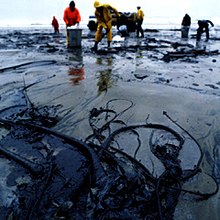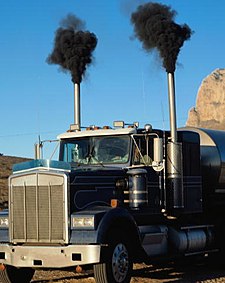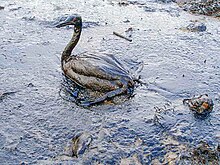User:Mardig94
| This user is a student editor in Concordia_University/HENV_680A_Current_Topics_in_Environmental_Science_(Winter_2018). |
This article needs additional citations for verification. (November 2011) |

The environmental impact of petroleum is often negative because it is toxic to almost all forms of life and its extraction fuels climate change.
Issues
[edit]This section needs expansion. You can help by adding to it. (July 2010) |
Toxicity
[edit]
Crude oil is a mixture of many different kinds of organic compounds, many of which are highly toxic and cancer causing (carcinogenic). Oil is "acutely lethal" to fish - that is, it kills fish quickly, at a concentration of 4000 parts per million (ppm)[1] (0.4%). Crude oil and petroleum distillates cause birth defects.[2]
Benzene is present in both crude oil and gasoline and is known to cause leukaemia in humans.[3] The compound is also known to lower the white blood cell count in humans, which would leave people exposed to it more susceptible to infections.[3] "Studies have linked benzene exposure in the mere parts per billion (ppb) range to terminal leukemia, Hodgkin's lymphoma, and other blood and immune system diseases within 5-15 years of exposure."[4]
Exhaust
[edit]
When oil or petroleum distillates are burned (see combustion), usually the combustion is not complete. This means that incompletely burned compounds are created in addition to just water and carbon dioxide. The other compounds are often toxic to life. Examples are carbon monoxide and methanol. Also, fine particulates of soot blacken humans' and other animals' lungs and cause heart problems or death. Soot is cancer causing (carcinogenic).
Acid rain
[edit]
High temperatures created by the combustion of petroleum cause nitrogen gas in the surrounding air to oxidize, creating nitrous oxides. Nitrous oxides, along with sulfur dioxide from the sulfur in the oil, combine with water in the atmosphere to create acid rain. Acid rain causes many problems such as dead trees and acidified lakes with dead fish. Coral reefs in the world's oceans are killed by acidic water caused by acid rain.
Acid rain leads to increased corrosion of machinery and structures (large amounts of capital), and to the slow destruction of archaeological structures like the marble ruins in Rome and Greece.
Climate change
[edit]Humans burning large amounts of petroleum create large amounts of CO2 (carbon dioxide) gas that traps heat in the Earth's atmosphere.
Oil spills
[edit]
An oil spill is the release of a liquid petroleum hydrocarbon into the environment, especially marine areas, due to human activity, and is a form of pollution. The term is usually applied to marine oil spills, where oil is released into the ocean or coastal waters, but spills may also occur on land. Oil spills may be due to releases of crude oil from tankers, pipelines, railcars, offshore platforms, drilling rigs and wells, as well as spills of refined petroleum products (such as gasoline, diesel) and their by-products, heavier fuels used by large ships such as bunker fuel, or the spill of any oily refuse or waste oil.
Major oil spills include , Lakeview Gusher, Gulf War oil spill, and the Deepwater Horizon oil spill. Spilt oil penetrates into the structure of the plumage of birds and the fur of mammals, reducing its insulating ability, and making them more vulnerable to temperature fluctuations and much less buoyant in the water. Cleanup and recovery from an oil spill is difficult and depends upon many factors, including the type of oil spilled, the temperature of the water (affecting evaporation and biodegradation), and the types of shorelines and beaches involved.[6] Spills may take weeks, months or even years to clean up.[7]
Volatile organic compounds
[edit]Volatile organic compounds (VOCs) are gases or vapours emitted by various solids and liquids, many of which have short- and long-term adverse effects on human health and the environment. VOCs from petroleum are toxic and foul the air, and some like benzene are extremely toxic, carcinogenic and cause DNA damage. Benzene often makes up about 1% of crude oil and gasoline. Benzene is present in automobile exhaust. More important for vapors from spills of diesel and crude oil are aliphatic, volatile compounds. Although "less toxic" than compounds like benzene, their overwhelming abundance can still cause health concerns even when benzene levels in the air are relatively low. The compounds are sometimes collectively measured as "total petroleum hydrocarbons" or "TPH."[8] Petroleum hydrocarbons such as gasoline, diesel, or jet fuel intruding into indoor spaces from underground storage tanks or brownfields threaten safety (e.g., explosive potential) and causes adverse health effects from inhalation. [9]
Waste oil
[edit]
Waste oil is oil containing not only breakdown products but also impurities from use. Some examples of waste oil are used oils such as hydraulic oil, transmission oil, brake fluids, motor oil, crankcase oil, gear box oil and synthetic oil.[10] Many of the same problems associated with natural petroleum exist with waste oil. When waste oil from vehicles drips out engines over streets and roads, the oil travels into the water table bringing with it such toxins as benzene. This poisons both soil and drinking water. Runoff from storms carries waste oil into rivers and oceans, poisoning them as well.
Mitigation
[edit]Conservation and phasing out
[edit]- Creating laws to completely phase out the use of petroleum (Sweden's 15-year plan)[11]
- Making use of petroleum more efficiently via better technology
Substitution of other energy sources
[edit]- Using "cleaner" energy sources such as natural gas and biodiesel, especially in critical areas like cities where there are people.
Use of biomass instead of petroleum
[edit]- It is suggested that cellulose from fibrous plant material, such as hemp, can be used to produce alternatives to many oil-based products.
- Plastics can be created from cellulose instead of from oil.
- Lubricants like motor oil and grease can be made from plants and animal fat.
Safety measures
[edit]- Decreasing the risk of spills
- False floors at gasoline stations to catch gasoline and oil drips from making it into the water table
- Double-hulled tanker ships
See also
[edit]- Arctic Refuge drilling controversy
- Environmental impact of the oil shale industry
- Environmental impact of the petroleum industry in Nigeria
- Environmental impact of hydraulic fracturing
- Energy and the environment
- Environmental issues of oil sands
- List of environmental issues
- Peak oil
References
[edit]- ^ Prasad, M. S.; Kumari, K. (1987). "Toxicity of Crude Oil to the Survival of the Fresh Water FishPuntius sophore (HAM.)". Acta Hydrochimica et Hydrobiologica. 15: 29. doi:10.1002/aheh.19870150106.
- ^ "Petroleum Solvents Overview". www.burke-eisner.com.
- ^ a b "Benzene Exposure on a Crude Oil Production Vessel -- KIRKELEIT et al. 50 (2): 123 -- Annals of Occupational Hygiene". annhyg.oxfordjournals.org. Retrieved 2010-06-07.
- ^ "Benzene pollution - a health risk in Gulf BP Oil drilling disaster - La Leva di Archimede (ENG)". www.laleva.org. Retrieved 2010-06-07.
- ^ Needs Citation
- ^ Lingering Lessons of the Exxon Valdez Oil Spill Archived June 13, 2010, at the Wayback Machine
- ^ "Hindsight and Foresight, 20 Years After the Exxon Valdez Spill". NOAA. 2010-03-16. Retrieved 2010-04-30.
{{cite web}}:|first=missing|last=(help) - ^ HDOH. "Field Investigation of the Chemistry and Toxicity of TPH in Petroleum Vapors: Implications for Potential Vapor Intrusion Hazards". Hawai'i Department of Health. Retrieved 8 December 2012.
- ^ U.S.EPA (11 June 2015). "Vapor Intrusion". U.S.EPA. Retrieved 13 June 2015.
- ^ State of Maine (www.maine.gov)
- ^ Article on Sweden's Phasing Out of Petrol Use (www.guardian.co.uk)
External links
[edit]- Information about petroleum spills in water from the State of New Department of Environmental Protection
- Safety Data Sheet -- Crude Oil (fscimage.fishersci.com)
- Beyond Katrina: Disaster on the Gulf Coast Continues --- 2010 Gulf of Mexico Oil Spill News, Information & Resources, 2008 Mississippi River Oil Spill Coverage
